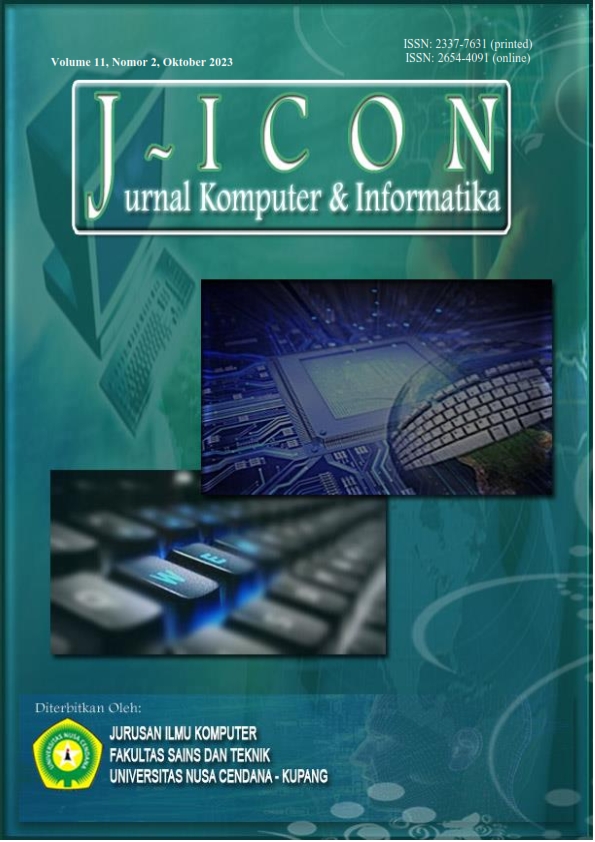Application of the Gray Level Co-Occurrence Matrix Method in Classifying Dragon Fruit Maturity Levels Based on Image
Abstract
Dragon fruit, also known as pitaya, is a fruit that originates from cactus plants belonging to the genus Hylocereus and Selenicereus, in the Cactaceae family, Cactaes order, and Dicotyledonae class. Dragon fruit is highly popular among people due to its various health benefits. The maturation process of dragon fruit begins approximately 11 months after planting, and it takes about 50 to 55 days from the formation of the flower bud to the fruit being ready for harvest. The maturation process of dragon fruit starts approximately 11 months after planting. From the moment the flower bud is formed until the fruit is ready to be harvested, it takes about 50 to 55 days. Dragon fruit has different levels of maturity, namely raw, half-ripe, ripe, and overripe. These maturity levels can be identified through changes in the fruit skin color. Currently, farmers still manually sort dragon fruit by directly observing the fruit's surface, but this method often leads to inaccurate and inconsistent classifications due to human error. Therefore, researchers are striving to develop a system that can classify the maturity levels of dragon fruit by utilizing Hue Saturation Value (HSV) color characteristics and implementing the Gray Level Co-Occurrence Matrix (GLCM) method. In the classification system developed using Matlab software, there are four maturity categories for dragon fruit, including raw, half-ripe, ripe, and overripe. This research achieved the highest accuracy of 90%. A total of 100 datasets were used, by using 5-fold-cross validation. Data analysis was performed using the GLCM method by calculating the nearest distance between each training and testing data using the Euclidean distance formula.
Downloads
References
S. Rahayu, Budidaya Buah Naga Cepat Panen, 1st ed. Jakarta: Infra Hijau, 2014.
N. Khuriyati, M. B. Fibriato, and D. A. Nugroho, “Penentuan Kualitas Buah Naga (Hylocereus undatus) Dengan Metode Non-Destruktif [Non-destructive Determination of Dragon Fruit (Hylocereus undatus) Quality],” J. Teknol. Ind. Has. Pertan., vol. 23, no. 2, p. 65, Sep. 2018, doi: http://dx.doi.org/10.23960/jtihp.v23i2.65-74.
Juherman, Mari berbisnis buah naga super red (Hylocereus undatus). Cianjur: PPPPTK Pertanian, 2017. [Online]: Available: https://bbppmpvpertanian.kemdikbud.go.id/?p=2243/. [Accessed 31 October 2023].
L. O. Prakoso, H. Yusmaini, M. S. Thadeus, and S. Wiyono, “Perbedaan efek ekstrak buah naga merah (Hylocereus polyrhizus) dan ekstrak buah naga putih (Hylocereus undatus) terhadap kadar kolesterol total tikus putih (Rattus norvegicus),” J. Gizi dan Pangan, vol. 12, no. 3, pp. 195–202, Nov. 2017, doi: https://doi.org/10.25182/jgp.2017.12.3.195-202.
A. Saragih and M. Sianturi, “Implementasi Metode Color Moment dan GLCM Untuk Mendeteksi Penyakit Tanaman Karet,” Inf. dan Teknol. Ilm., vol. 7, no. 2, pp. 145–151, 2020, [Online]. Available: https://www.ejurnal.stmik-budidarma.ac.id/index.php/inti/article/view/2377. [Accessed 31 October 2023].
R. Widodo, A. W. Widodo, and A. Supriyanto, “Pemanfaatan Ciri Gray Level Co-Occurrence Matrix (GLCM) Citra Buah Jeruk Keprok (Citrus reticulata Blanco) untuk Klasifikasi Mutu,” J. Pengemb. Teknol. Inf. dan Ilmu Komput., vol. 2, no. 11, pp. 5769–5776, 2018, [Online]. Available: https://j-ptiik.ub.ac.id/index.php/j-ptiik/article/view/3420. [Accessed 31 October 2023].
N. Idawati, Budidaya Buah Naga Hitam : Varietas Baru Yang Kian Diburu. Yogyakarta: Pustaka Baru Press, 2012.
R. Nisa, R. Mulfianda, and M. Mulyatina, “Efek Buah Naga Merah (Hylocereus Polyrhizus) Terhadap Penurunan Kadar Gula Darah Pada Penderita Diabetes Mellitus Tipe 2,” Idea Nurs. J., vol. XII, no. 2, pp. 19–25, 2021, [Online]. Available: https://jurnal.usk.ac.id/INJ/article/download/22245/15393. [Accessed 31 October 2023].
R. Gonzalez and R. Woods, Digital Image Processing Third Edition, 3rd ed. New Jersey: Pearson Prentice Hall, 2010.
A. S. Maulani, Klasifikasi Batik Menggunakan Metode Multi Texton Histogram dan Support Vector Machine [Skripsi]. Malang: Teknik Informatika, Universitas Muhammadiyah, 2017.
D. Amirullah, “Sistem Pencarian Semantik Impresi dengan Mekanisme Pembobotan Kombinasi Fitur Warna dan Fitur Bentuk,” INOVTEK Polbeng - Seri Inform., vol. 3, no. 1, p. 41, 2018, doi: https://doi.org/10.35314/isi.v3i1.332.
G. Gressiva and F. Chandra, “Sistem Pengenalan Motif Songket Melayu Menggunakan Ekstraksi Fitur Principal Component Analysis dan Gray Level Co-Occurrence Matrix dan Jaringan Saraf Tiruan,” J. Jom FTEKNIK, vol. 5, no. 2, pp. 1–7, 2018. [Online]. Available: https://jom.unri.ac.id/index.php/JOMFTEKNIK/article/view/22206. [Accessed 31 October 2023].
Y. R. Kaesmetan and M. V. Overbeek, “Digital Image Processing using Texture Features Extraction of Local Seeds in Nekbaun Village with Color Moment, Gray Level Co Occurance Matrix, and k-Nearest Neighbor,” Ultim. J. Tek. Inform., vol. 13, no. 2, pp. 81–88, 2022, doi: https://doi.org/10.31937/ti.v13i2.2038.
I. Purnamasari and T. Sutojo, “Pengenalan Ciri Garis Telapak Tangan Menggunakan Ekstraksi Fitur (GLCM) dan Metode K-NN Palm Characteristic Recognition Using Feature Extraction (GLCM) and K-NN Method,” J. VOI (Voice Informatics), vol. 6, no. 1, pp. 221–229, 2017. doi: https://doi.org/10.33050/ccit.v10i2.541.
Copyright (c) 2023 Marni Monika Folla, Semlinda Juszandri Bulan

This work is licensed under a Creative Commons Attribution 4.0 International License.
The author submitting the manuscript must understand and agree that if accepted for publication, authors retain copyright and grant the journal right of first publication with the work simultaneously licensed under a Creative Commons Attribution (CC-BY) 4.0 License that allows others to share the work with an acknowledgment of the work’s authorship and initial publication in this journal.
 Marni Monika Folla(1*)
Marni Monika Folla(1*)




